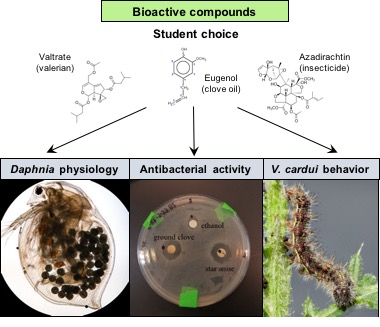
Engaging and supporting introductory level students in authentic research experiences during required coursework is challenging. Plant bioactive compounds attract students' natural curiosity as they are found in many familiar items such as tea, coffee, spices, herbs, vegetables, essential oils, medicines, cleaning supplies, and pesticides. Over the course of one semester, students work in teams to design experiments in three experimental modules to test whether bioactive compounds have effects on Daphnia heart rate, antibacterial activity, or caterpillar behavior. In a fourth module, they research solutions to an environmental problem. Students are involved in multiple scientific practices as they make their own experimental decisions, analyze data including using statistics to carefully justify their preliminary conclusions, and have the opportunity to improve their experiment and repeat it. Iteration is also emphasized by the fact that students go through the whole process from design to presentation repeatedly for three experiments. In the process, students experience for themselves the real complexity of scientific investigations and what it takes to rigorously show cause-and-effect relationships. The pedagogical focus is on providing introductory students with a supportive structure in a way that empowers them to make informed experimental decisions and be successful. At the end of the semester, the majority of students displayed a strong sense of personal involvement and an appreciation of the difficulties of scientific experimentation in open-ended written reflections. Students reported that statistics was one of the most difficult yet valuable experiences in these labs and demonstrated significant gains on a statistical test.
Primary image: Summary of the Lesson showing that student decide on which bioactive compounds to test in three model organisms (image attributions listed in Acknowledgments).

Heather Evans onto CURES
@
on